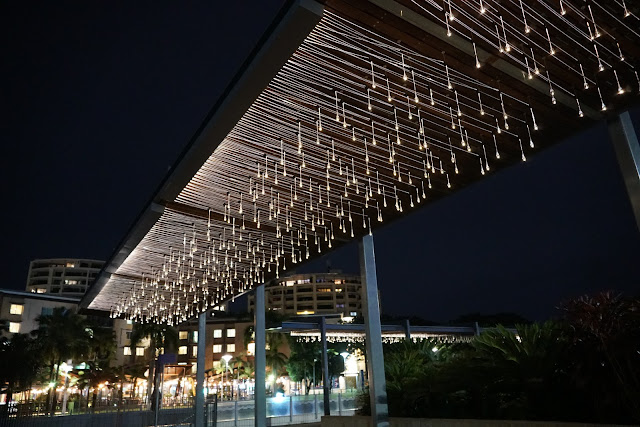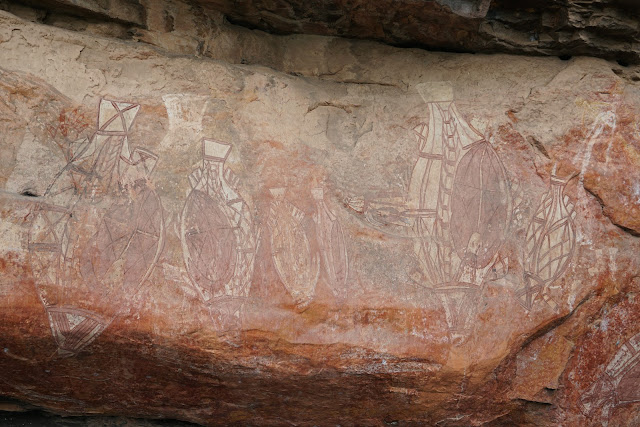The Northern Territory (NT) is huge and roughly divided into to 2 big parts - the Top End and the Red Centre. The Top End enjoys the tropical and rainforesty climates and covers Darwin, Kakadu National Park, Arnhem Land and Katherine area. The bottom of NT is the Red Centre consisting of Uluru, Alice Spring.
The NT has 2 main seasons, the Wet (November to April) and the Dry season (May to October). However according to the local Gundjeihmi, there are 6 different seasons.
Gudjewg (Monsoon): December to March
Banggerreng (Harvest time): April
Yegge (Cooler but still humid): May to June
Gunumeleng (Pre-monsoon): October to December
Gurrung (Hot dry time): August to October
Wurrgeng (Cool dry season): June to August
Almost 6 years ago, over a Good Friday/Easter Sunday holidays, I did a 3 days visit to Uluru and really enjoyed the experience. Australia being such a big land, it is significantly different being in NT versus the usual capital cities.
This round, I took advantage of the Labour Day long weekend and did a quick 3-days to the Top End with a friend. So yep, I was at the Top End during the monsoon season. In fact, the plane had to circled a bit before attempting to land due to the monsoon rain as we arrived to Darwin.
It was a long weekend but because of the flight timing, we get exactly 3 full days by arriving just past midnight on a Saturday and departing Darwin very early morning (1am) on a Tuesday. No annual leave taken.
Here goes.
Day 1: Darwin (1 night)
After picking up our rented car, we proceeded straight to the Darwin CBD where we booked a night at the H on Smith Hotel. Room was clean and updated but breakfast was forgetable.Post breakfast, we wandered a little around this quiet CBD towards the Waterfront Precinct.
 |
| Christ Church Cathedral - where new cathedral was constructed around a historic porch |
 |
| Darwin Waterfront Precinct |
 |
| Indonesian satay with peanut and chilli sauce |
 |
| Eggplant bao |
We didn't want to arrive in Kakadu in the dark plus wanting to leave some time for detour, so we left Darwin just after. Our first stop after leaving Darwin was Window on the Wetlands Visitor Centre. The visitor centre is on Beatrice Hill, one of the highest points overlooking the Adelaide River floodplains. There are interactive displays to explain the Aboriginal and European histories of the area, plus the wildlife in the area.
A short 5 minutes away was our next stop, the Original Adelaide River Queen Jumping Crocodile Cruises. It was a last minute decision so we went to the nearest and joined the last departure of the day at 3pm. It went for an hour and the crocodiles were just next to the boat.
 |
| The jumping one |
 |
| The non jumping one.. because this was a big one and a little too heavy to jump |
Day 1 ended when we arrived in Jabiru and checked in for the next 2 nights.
Day 2: Kakadu National Park
First stop was to the Bowali Visitor Centre to pay for the Kakadu National Park pass as well as checking which sites in the national park that were still accessible. Many sites were closed high water levels due to frequent rainpour in the monsoon seasons.We went on our merry way to the Kubara pools walk, a 6km return walk past sandstone cliffs to shady monsoon forest pools. The staff whom we spoke to said that this is one of her favorite walks. However we didn't see the pools even though we went as far as taking off our shoes and crossed barefooted a big puddle of water.
The water was clean and it was refreshing but walking barefooted on the stones was similarish to the having reflexology which I don't do very well. After navigating through that puddle of water, we arrived to the start of the walk, only to see a string to prevent one from going further and caution signs to beware of crocodiles and buffalos. Considering that many sites were inaccessible due to water levels so we decided to turn back.
We repeated the take-off-shoes-and-cross-puddle exercise and that was the end of our Kubara pools walk.
So we went to the next walk near to Kubara pools walk, Nanguluwurr art site walk. This was described as a 3.4km return walk through woodlands to a quiet Aboriginal rock art site and to allow 2 hours.
We didn't think it took 2 hours, though I was hoping that there were more to the art considering that the walking to the art site took a while. It definitely felt a long walk especially it was really humid-warm the day of our visit.
We then returned to the hotel for lunch and decided to do the cruise on the Yellow Water. Friend went to make the booking and I was tasked to get a takeaway box for the pizza that we were going to eat-in. I accidentally became a 'pizza thief' after I left promptly after puting the pizza to the box, thinking that it would be billed to the room. I did ring the hotel reception to own up, just in case. ;)
I really enjoyed the Yellow Water (Ngurrungurrudjba) Cruise which went on the Yellow Water Wetlands and the guide talks about the nature and culture. It was a little pricey though at $90 for 2 hours because we did the 4:30pm slot. The earliest slot is the most expensive as it includes breakfast and the ones during the day are shorter so are cheaper comparatively.
At certain areas at Yellow Water are closed to boating to prevent spread of salvinia, a free-floating aquatic fern native to South America. It was originally imported as an aquarium plant but reproduces very rapidly by growing from small fragments.
 |
| Darter bird drying its wings |
Day 3: Kakadu National Park, Darwin
We stopped by the Bowali Visitor Centre again as friend wanted to check out the Marrawuddi Gallery at the visitor centre which stocks Aboriginal arts, crafts, books and gifts. She got a cool art piece of a Mimi spirit. In the meantime, I rounded the visitor centre and saw this large termite mound.We planned to stopby the Litchfield National Park to check out a couple of things including the magnetic termite mounds at the Litchfield National Park. Unfortunately we were caught at Scott Creek and stopped to wait for the water levels to recede. After we passed through this patch of the road, we decided to just continue all the way to Darwin to be on the safe side.
On arrival to Darwin, we went on a little hunt to find Kakadu plum and found them at the Aboriginal Bush Traders. I wasn't familiar with it but according to friend, it is a superfood and contains high concentration of vitamin C.
We also visited the Mindil Beach even though the Sunset Market is not yet opened.
It was quiet apart from a handful other families who brought their dogs out for a run. We weren't expecting to see any sunset as it was cloudy the whole day but Mindil Beach did throw us a pretty sunset show which we caught when we had dinner at a nearby restaurant.
Our last activity of the day was to see the Bruce Munro Tropical Lights. It is an outdoor exhibition of illuminated sculptures across the CBD and they are lighted up nightly from 7pm-10pm. The city is taking this exhibition seriously, we found out that staffs are engaged to patrol around to ensure that the lights are still working, the exhibitions are still intact etc.
Here are the illuminated sculptures.
 |
| Pukul Lima (Temperate Clock), 2019 |
 |
| Telegraph Rose, 2019. This one comes with an audio element of morse code. |
 |
| Green Flash, 2017. This is express the optical phenomena which occurs right after sunset or before sunrise, for a second of two. (Well, saw it, didn't snap it in time but didn't want to wait again) |
 |
| Time and Again, 2019 (37 stainless steel lily pads forming a convex done with each lily with a design to represent past, present and future) |
 |
| Sun Lily, 2019 (Created uniquely for Darwin, with the Spider Lily in the heart of the sculpture) |
 |
| Light Shower, 2019 |
 |
| Water-Towers, 2010 |
Side note: Stay safe
















2 comments
Wait ... Northern Malaysia ... so your favorite type of Laksa is?
ReplyDelete(Assam?)
Spot on! I also like the version with combination of asam and lemak. The lemak laksa Kedah is made of sambal paste that consist curry and coconut but still not curry laksa. The lemak in this context means more of rich flavour. ^^
Delete